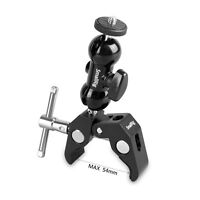About
Reviews (2)

Sep 16, 2018
One of the most useful tools in the camera bag!
This clamp is quite possibly the most useful tool in my main camera gear bag. My most frequent use is to clamp an audio recorder to a tripod or mic stand, but I have used this clamp/arm setup for many other things such as mounting an action camera to a pipe and a DSLR to the side of a desk. The only minor complaint I have is that the arm can be unscrewed from the mount threads in the clamp if you don't ensure it is tightened enough; I removed the arm from the mounting ball and tightened the base of the mounting ball with some pliers and have not had an issue since.

Nov 14, 2018
Still a useful camera 18 years after its release, but not up to modern standards
1 of 1 found this helpful I'll be perfectly honest if you want a bottom line: you shouldn't be buying this camera today if you're not chasing nostalgia or curiosity. If you want a recommendation for a great point-and-shoot camera that's very cheap today, look at another camera I own and keep with me all the time: the Canon PowerShot SX120 IS. No one in this age of smartphone cameras everywhere will ever be as happy with a Kodak DC3200. It has aged well past its prime and doesn't live up to modern standards.
I had this camera in high school and was pleasantly surprised to have a chance to purchase it again here. The battery door on my new one was broken just like my original one. The door clips are plastic and the springs for the batteries are extremely strong, so they'll probably be busted on every DC3200 today. The good news is that a thick rubber band like you get on a bundle of celery will hold the door shut and won't block any controls on the camera.
Image quality is quite good for its age, but buyers must be aware that the largest JPEG image it can take is a measly 1152x864 pixels, nearly the same pixel count as a 1280x720 or 1366x768 widescreen. You will probably not want to print 8x10s of the images from this camera today. The images don't tend to scale very well, but if you view them at 100% size or smaller they are just fine.
A distinct advantage of this camera is its absurdly simple controls. You need to set the image quality as high as it'll go, but other than that it's the definition of "point and shoot." There is no zoom...well, there is, but it's only in low-quality mode and the zoom is nothing more than a crop out of the middle of what would be a high-quality mode photo anyway. There is no focus mechanism because it's a fixed-focus design; basically anything from about 3ft away is always in focus. The aperture and ISO are fixed at f/3.4 and ISO 100. There are no manual controls other than a flash toggle button. It may be the simplest camera to use.
Because of the narrow aperture and very low ISO sensitivity, this camera has extremely slow shutter speeds indoors which means tons of motion blur with the flash off. If you turn the flash on, be aware that THE FLASH IS ***EXTREMELY*** BRIGHT. Anyone remotely close to the camera will be blown out by the bright flash with the background darkened close to black. It's so bright because at ISO 100 you really need that much extra light to take a decent photo indoors. You can reduce the flash brightness by taping some translucent tape or a piece of thin paper over it which will diffuse and absorb some of the blinding light, or by holding your hand in a way that bounces it up and off the ceiling instead, which has worked for me in the past.
The photos in this review were taken in 2002 and include one each of a bright daytime, cloudy daytime, indoor low-light, and moving shot in a tunnel. This should give you a better idea what you're getting into with this camera.
